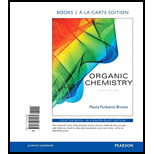
(a)
Interpretation:
The major product should be given, if
Concept introduction:
Aromaticity:
The
The organic molecule must planar, cyclic and conjugate and satisfy the
(b)
Interpretation:
The major product should be given, if the carbocation forms phenol by losing
Concept introduction:
Aromaticity:
The aromatic compounds are type of organic compounds, which has a special property’s in the reactivity and structure, they are,
The organic molecule must planar, cyclic and conjugate and satisfy the
Want to see the full answer?
Check out a sample textbook solution
Chapter 10 Solutions
Organic Chemistry, Books a la Carte Edition (8th Edition)
- SO3H 69. Which of the following is not true of SN1 reactions? A. They are favored by nonpolar solvents. B. The concentration of nucleophiles does not affect the rate of reaction. C. Tertiary alkyl halides generally react through this mechanism. D. They occur through a 2-step concerted reaction. Refer to the reaction to answer the items 70 to 72. ОН CS₂ - Bra 70. What is the minor product formed from this reaction? A. o-bromophenol B. p-bromophenol C. m-bromophenol D. Both A and Barrow_forwardIdentify the reagents that will form the product in the reaction below. a. HBr O b. 1. Disiamylborane, 2. H202, NaOH O c. Cl2, H20 O d. H20, H2SO4, H9SO4 Oe. 1. BH3•THF , 2. H2O2, NaOH е.arrow_forwardIn which of the following solvents would the reaction of 1- bromobutane with sodium azide, NaN3, proceed the fastest? a. acetic acid b. ethanol c. water d. acetonitrile a O barrow_forward
- a. Identify the substitution products that form when 2-bromo-2-methylpropane is dissolved in a mixture of 80% ethanol and 20% water. b. Explain why the same products are obtained when 2-chloro-2-methylpropane is dissolved in a mixture of 80% ethanol and 20% water.arrow_forward43. Identify the reagent that will produce the following brominated product in greatest amount. Br A. Br₂/uv ? B. Br2/FeBr3 C. NBS D. Br2/CC14 44. Under acidic condition, which of the following compounds can not be oxidized by KMnO4. A. toluene B. 2-butene C. methylcyclohexane D. 2-butynearrow_forwardChoose the reagent(s) that would be most likely to complete this reaction. OH Q a A B C D E 1. OSO4 (catalytic) NMO Br2 H₂O 1. Hg(OAc) 2, H₂O 2. NaBH4, NaOH RCO3H 1. BH3-THF 2. H2O2, NaOHarrow_forward
- Choose the reagent(s) that would be most likely to complete this reaction. HO 1. Hg(OAc)2, H2O 2. NaBH4, NaOH Q Q 1. OsO4 (catalytic) A 2. NMO Br2 B H2O 1. BH 3-THF C 2. H2O2, NaOH 1. Hg(OAc)2, H₂O D 2. NaBH4, NaOH E RCO3Harrow_forwardHow does gold help to catalyze the reaction in the gold catalysis experiment? It deprotonates the methanol, making methanol a better nucleophile. оа. o b. It donates electron density to the alkyne, making the alkyne a better nucleophile. О с. It coordinates to the methanol, making methanol a better nucleophile. o d. It coordinates to the alkyne, making the alkyne a better electrophile.arrow_forwardWhich of the following starting materials and reagents would be best to produce a racemic mixture of 3-methyl-3-hexanol? a. heptanone and 1. CH3MgBr 2. H3O+ b. hexanal and 1. CH3MgBr, 2. H3O+ c. 3-hexanone and 1. CH3MgBr, 2. H3O+ d. butanal and 1. CH3CH2MgBr, 2. H3O+arrow_forward
- 14. What is the best choice of reagent to perform the following transformation? Br A. HBr B. Br2, CH2C12 ragien C. H2,Pt D. Br2, H2Oarrow_forwardThe alkyl halide shown reacts with sodium methoxide to form an organic product. H3C Br NaOMe H3C. CH3 major organic product H C CH3 Determine whether this reaction proceeds by SN1, SN2, E1 or E2 and identify the major organic product. Step 5: Draw the major elimination product expected in the reaction. Draw the product. Select Draw Rings More H₂C Br 2 H3C. 1 CH3 H₂ 4 CH3 5 NaOCH3 Erasearrow_forward5. In an organic reaction, which of the following is most likely to function as only a nucleophile? a. BF3 b. (CH3)2CH2NH2 с. Fe2+ d. CH3CH2S¯ e. both a and carrow_forward
 Organic Chemistry: A Guided InquiryChemistryISBN:9780618974122Author:Andrei StraumanisPublisher:Cengage Learning
Organic Chemistry: A Guided InquiryChemistryISBN:9780618974122Author:Andrei StraumanisPublisher:Cengage Learning
